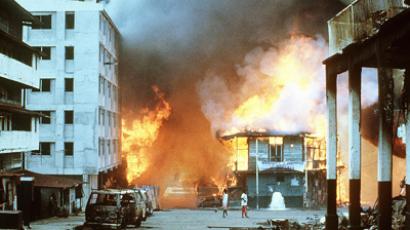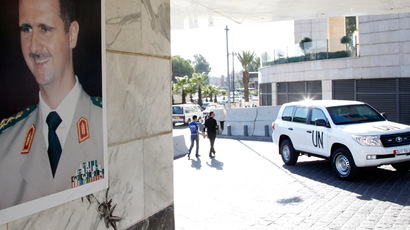Panama hopeful US will finally clean up chemical weapons left from WWII

Panama and the United States are locked in a dispute over unexploded chemical weapons US soldiers left on an island of the Central American country over 60 years ago, now in the way of a major canal expansion project.
Panamanian officials say they are growing more optimistic that
its campaign to compel the US to retrieve its own weapons will be
recognized by the Barack Obama administration despite
disagreements in the past, McClatchy reported.
The new expectations from Panama come as the US has pressured
Syria to eradicate its chemical munitions in the wake of what the
superpower alleges was a sarin attack carried out by the Assad
regime on civilians near Damascus on Aug. 21.
Yet the Obama administration itself is less clear on any
agreement to clean up thousands of pounds of bombs on San Jose
Island, 60 miles southeast from Panama City in the Pacific Ocean.
The World War II ordnance was left on the island following a
two-year term, from 1945 to 1947, when about 200 US soldiers used
the then-deserted island to test chemical weapons that included
phosgene, cyanogen chloride and mustard gas. Other reports
maintain the soldiers also tested VX nerve gas and sarin, the
lethal agent the Organization for the Prohibition of Chemical
Weapons found had been used in Syria on Aug. 21.
A Panamanian survey in 2002 found at least eight unexploded 500-
to 1000-pound bombs remain on the 17-square-mile island with an
abundance of deer and wild pigs and surrounded by rugged
shoreline.
“The expert feeling is that whatever is in those bombs is
probably not dangerous,” said Tomas A. Cabal, the head of the
anti-terrorism analysis unit at the Foreign Ministry. Yet he
added remaining canisters hold explosive detonators that are less
stable.
In 2003, the US offered to train Panamanians to deal with such
munitions as long as Panama waived any United States liability.
Panama declined, demanding the Pentagon fulfill its obligation to
dispose of the toxic ordnance.
Panama is hopeful based on the Pentagon’s pledge to send a team
to survey the munitions on the island later this year, Foreign
Minister Fernando Nunez Fabrega told McClatchy.
“I have a firm commitment from the United States,” Nunez
Fabrega said.
In May, Panama appealed to the Organization for the Prohibition
of Chemical Weapons - the body based in The Hague, Netherlands,
that is leading the destruction of Syrian munitions - for
the US to remove the unexploded bombs.
Cabal, who was a part of the clean-up negotiations at The Hague,
said US delegates only requested Panama change one aspect of its
petition for the recovery to happen.
“They requested that we change the wording to read that they had
not ‘abandoned’ but that they had ‘forgotten’” the weapons,
he said.
For its part, the Obama administration is less clear on what the
next steps are for the weapons.
“The U.S. government is reviewing Panama’s request concerning the
munitions on San Jose Island and is committed to resolving this
issue in a timely manner,” said Jennifer D. Elzea, a Pentagon
spokeswoman.
The US soldiers arrived on the island to evaluate “chemical
warfare under tropical conditions,” according to a 1988 US
Army book, “The Chemical Warfare Service: From Laboratory to
Field.”
“These studies gave the participants valuable data on the
offensive and defensive phases of chemical warfare in jungle
fighting,” the book says.
These and other leftover munitions following the US concession of
the Panama Canal in 1999 became a sore spot for the Panamanian
government, as it rejected the 2003 US offer to train in exchange
for exoneration says Jose Miguel Aleman, the country’s foreign
minister from 1999 to 2003.
“It was not acceptable to us because it did not comply with
the OPCW treaty, which says that any nation that abandons
chemical weapons is responsible for cleaning up those
weapons,” Aleman said.
When the US ratified the Chemical Weapons Convention in 1997, it
said it had not left chemical weapons in any other nation’s
holdings.
Ramon A. Morales, Panama’s ambassador to the United Nations from
1999 to 2004, said the US munitions are still a problem for the
country of around 3.6mn people.
“Unofficially, it is known that there have been some 20 deaths by
people who have handled this (unexploded ordnance),” Morales
said.
He said it’s been difficult for the small country to compel the
removal of much of anything in the way of explosives or
pollutants left throughout Panamanian jungles by the US.
“It’s very hard for a little country like Panama to shake out
the information from the world’s most powerful country,”
Morales said.
Morales said a $5.25bn expansion of the Panama Canal has stalled
because crews have had to deal with buried ordnance.
“This shows how expensive the problem has been for us,”
Morales said.
Spokesman for owners of the private San Jose Island, John Zima,
told McClatchy abandoned chemical munitions lie on an area that
takes up about 9 percent of the island. He said the owners are
eagerly anticipating ridding the island of the toxic munitions,
as they have plans to build up the largely virgin territory,
“perhaps another hotel, selling some lots around the hotel,
maybe some golf courses.”
“Why it took so long or anything like that, it doesn’t matter.
We’re excited that it’s going forward,” Zima said. “The
Americans are living up to their obligations. They are actually
doing the right thing.”
The United States has had a large footprint in the country over
the last century, helping it sever ties with Colombia in 1903
only to be put under US sovereignty. Thousands of American
soldiers were stationed there to develop the Panama Canal.
In 1999, the US ceded control of the canal to Panama and many
military bases set up around the country.
Yet Panama complained that the bases were littered with over
120,000 rounds of medium- and large-caliber munitions, such as
mortar rounds.
Watchdog groups have said the US may have tested chemical weapons
in as many as 16 sites throughout Panama.














